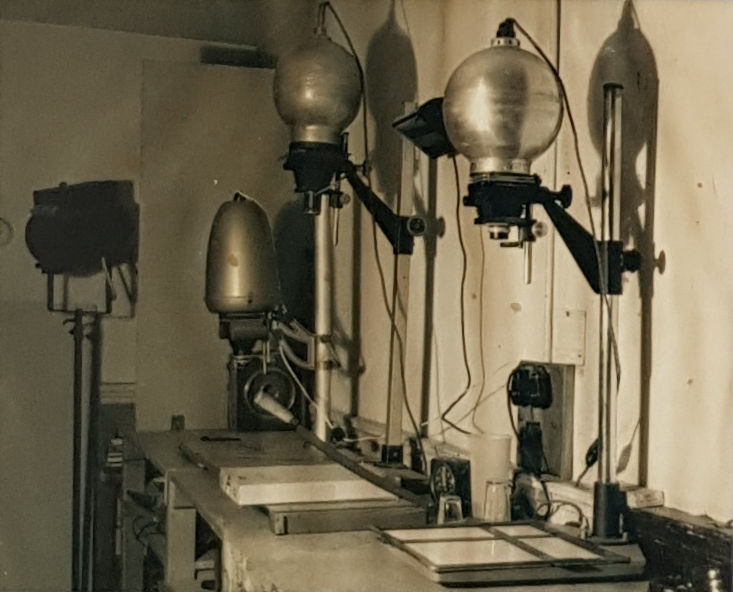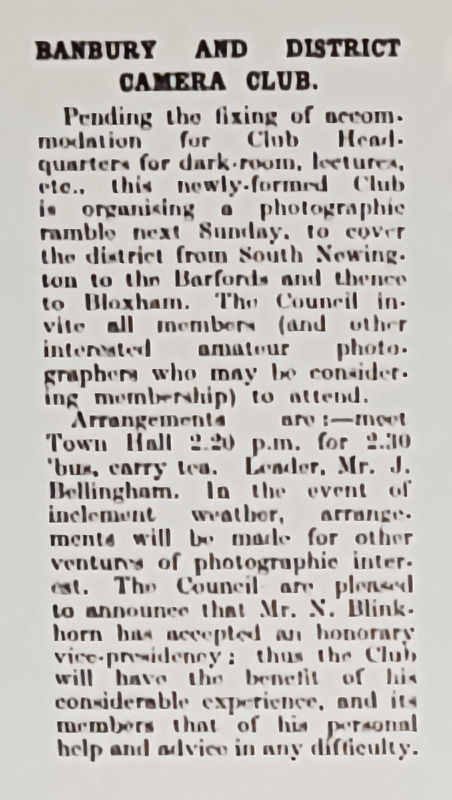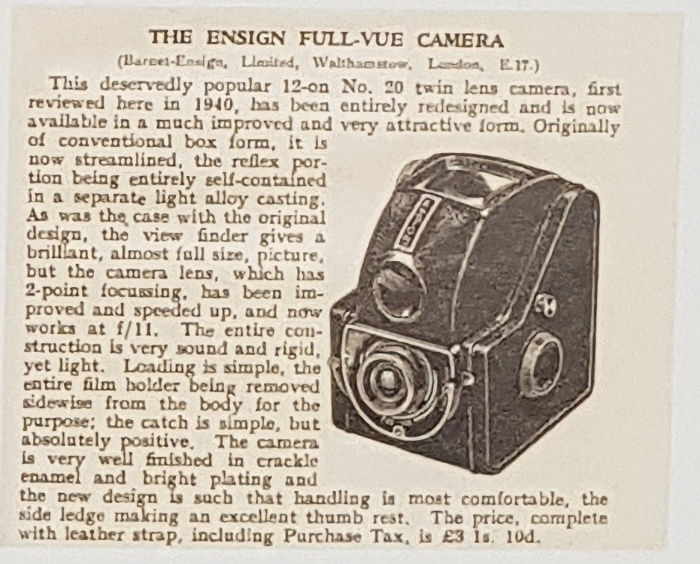
Beginnings

The Banbury and District Camera Club, as it was first known, was founded in 1946 by a group of enthusiastic photographers, the aim being to bring together all those interested in photography and to improve the standard of amateur work in the district. The very first event was announced in the Banbury Guardian on 6 May 1946. The first meetings were held in Norman Blinkhorn’s studio, or the ironmongery shop of John Gardner at the corner of Parsons Street and Church Lane. A plaque now commemorates Mr Gardner’s shop. The earliest meetings consisted of talks and demonstrations by members, quizzes and shows of members’ prints and films. In 1948 a room was rented in a basement in West Bar, where a club room and darkroom were fitted up.

Isabel Smith joined in 1948 and recalled “the roaring fire which helped to combat the dampness of the basement, and the awe and respect with which I regarded those expert photographers who produced such wonderful and painstaking prints!” The very first page of the club’s Cash Book records sums of 19/11d (almost £1) for “Timber for darkroom”, and £15 19s 2d (£15.97)for enlargers. The kind of equipment which was used in the club’s darkroom is illustrated in this photograph which was taken at 51 The Green, then the School of Art, to which the club moved in 1952 and where it remained until 1984. Initially, the club had its own darkroom-cum-clubroom, as shown and a room to use as a studio. With this link, the School of Art’s twelve week photography course was run in association with the camera club, as reported in the Banbury Guardian in March 1952.

Gratton Darbishire — An Early Member
Among the members in the club’s first year, Gratton Darbishire, who farmed near Byfield, joined in March 1947. Bearing in mind the entry on the 1947 winter, it’s perhaps surprising that the road from Byfield to Banbury was open. Gratton was a very accomplished photographer and, from the quality of the many prints which are still prized by Byfield residents, it’s clear that he had an excellent camera and first-rate darkroom skills. He is the only member from that first year for whom we have photos taken at the time. The examples below are taken from the Byfield Photo Museum, a collection of around 3,500 photos of Byfield and the surrounding area, dating back to 1870. While long aware of Gratton’s photos in that collection, we only discovered that he had been a member of the camera club when Alan Sargent’s researches in the Banbury Guardian on-line archive found a reference to his membership in a report of his wedding. Gratton’s bride, Dorothy Mary Dearden, “wore a French brocade wedding gown with a headdress of lilies, and carried a bouquet of carnations.” We can only assume that Gratton wore a suit.
Banbury Guardian for 6 May 1946 – The first mention of the club

The newly-formed club’s first event was a “photographic ramble” on Sunday 12 May. The members, advised to “carry tea”, were to meet at Banbury Town Hall and travel by the 2.30 bus to South Newington for the start of the ramble to Bloxham. They could easily use the scheduled service as there were just nine members at that time.
1946 — The wider picture
There were 22 members in that first year and the club’s annual subscription was one guinea (£1.05). That really was a significant sum — a substantial fraction of a week’s wages for many workers. Average annual earnings then were £280 (equivalent to around £8,500 in 2016). The subscription remained at £1.05 until 1963.
Aftermath of War
This advertisement, from Ross of London, in the 1946 issue of the British Journal Photographic Almanac, reminds us how soon this was after the war: “… at long last we are being released from the manufacture of War Winning Optical Instruments.”
Scarcity of Cameras

That same issue of the 1946 Almanac has a review of the new equipment, accessories and chemicals introduced in the year. There is a grand total of two cameras, both of British manufacture. This Ensign Full-Vue took roll film, had very limited controls and, at £3 is 10d (£3.09), it was not a cheap purchase. Even if they had the money, members of the Banbury Camera Club would have had a very restricted choice of new cameras and would mostly have relied on pre-war designs. Isabel Smith is an earlier camera in the photo above.
Now that, at long last, we are being released from the manufacture of War Winning Optical Instruments, the great resources and modern manufacturing methods of the ROSS organisation can largely be turned to supplying peace-time needs. Much that is good has come out of the war. Necessity —in the 1939-40 period—created problems that had to be solved.
1947 – A winter to remember
Beginning on 21 January 1947, cold spells brought large drifts of snow to the country, blocking roads and railways. Power stations were starved of coal and electricity supplies were severely restricted. Radio broadcasts were limited, television services were suspended, some magazines were ordered to stop being published and newspapers were cut in size. Towards the end of February there were also fears of a food shortage, as supplies were cut off and vegetables were frozen into the ground. Milder weather in March brought severe floods.
1950s and 1960s
For the early activities of the club we have very few sources: the Cash Book from 1946 onwards, a handful of references in the Banbury Guardian and, most important, the account which Isabel Smith wrote in 1989.
Public Activities
Isabel described some of the ways the club contributed to Banbury life. “In the fifties and early sixties there were public exhibitions, well attended by the public and officials such as the Mayor and the local MP, shows by Gevaert and Kodak were held on several occasions.” It was common in this period for photographic companies to sponsor lecturers. Notices in the Banbury Guardian list Kodak and Ilford as sponsors, as well talks by the editor of Good Photography and by Lancelot Vining, a Fleet Street photographer who had a weekly column in Amateur Photographer. The club ran a colour slide competition, open to all in the Banbury area, and also took photographs for the North Oxfordshire Technical College prospectus.

The 1950s and into the 1960s was a very successful time for the club, though the annual jumble sales advertised in the Banbury Guardian suggest that fund-raising was an issue. The membership reached 54 in 1963, by which time there were three sections, catering for black and white, colour slide, section having evenings devoted to its particular interest. The members of the cine section left in the same year to form their own club.

An Impressive Project — Photographing the Mayor in 1959 Isabel describes the production of a huge 6 ft by 4 ft portrait of the Mayor of Banbury. This was all done in the club room on the top floor of 51 The Green from a 4 cm by 4 cm negative — taking the picture (when the Mayor, Miss Gwendoline Bustin, arrived with the Macebearer carrying the robes and regalia), enlarging the negative on a large sheet of photographic paper pinned to the wall, developing the print in a ‘dish’ made from 4in x 4in wood lined with plastic (thank goodness it didn’t leak or the college authorities would have had something to say), fixing the print in the same dish with members gathered round with large sponges to keep the agitation going, the print finally being taken home rolled up in the leg of my husband’s pyjamas to wash in the bath. For a short time this portrait was hung over the stairs in the Town Hall, but it mysteriously disappeared about 1984.” It’s likely that Isabel used her own camera for this photo — the excellent Rolleiflex 4 x4 of German manufacture.
